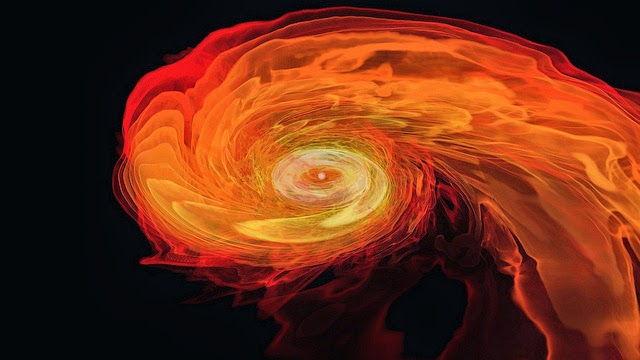This supercomputer simulation depicts one of the most powerful events in the universe: two neutron stars colliding, merging, and becoming a black hole. A neutron star is the compact core left behind when a star with between eight and thirty times the mass of the sun explodes as a supernova. The mass of a neutron star is around 1.5 times that of the sun squeezed into a ball 12 miles wide. As the simulation begins, we see an unequally matched pair of neutron stars with masses of 1.4 and 1.7 solar masses. They are separated by only around 11 miles, which is little less distance than their respective diameters. Redder colors denoted areas with decreasing density.
Penetrating currents begin to crush the stars as they spiral to each other, possibly shattering their layers. Neutron stars have incredible density, although their outer layers are somewhat thin, with densities a million times that of gold. Their cores crush matter to a considerably larger extent, and densities increase by 100 million times. To put such mind-boggling densities into perspective, consider that a cubic centimetre of neutron star material weighs more than Mount Everest. Scientists believe that neutron star fusions like this one cause brief gamma-ray bursts (GRBs). Short GRBs last less than two seconds yet emit as much energy as all the stars in our galaxy do in a year.
(If you find any error or miscalculation in this article then please feel free to share in comment and if you want to expand this article then comment below)



It seems the relation of the sizes of the initial objects and the final object is off. Why is the final object's volume less than a percent of the initial objects.
ReplyDeleteBesides, the simulation does not consider relativistic effects. These should be very much visible, as neutron stars are not much larger than the event horizon of a black hole.
This is an awesome motivating article.
ReplyDeleteYou put truly extremely accommodating data. Keep it up.
ReplyDeletethank you for sharing such a great bog it is very helpful.
ReplyDeleteYour article has answered the question I was wondering about!
ReplyDelete